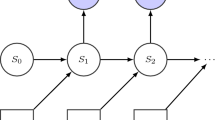Abstract
Autonomous learning systems of significant complexity often consist of several interacting modules or agents. These modules collaborate to produce a system which, when viewed as a whole, exhibit behaviour that can be interpreted in some way as learning. In designing these systems, the complexity of the interactions of large numbers of modules can become overwhelming, making debugging difficult and obscuring the workings of the system when viewed from an architectural level. A way of controlling system complexity called the Layered Learning System architecture (LLS) has been developed, which offers the advantages of incremental development and testing, easier debugging and progressive upgrading facilitation. A hexapod robot has been implemented using LLS principles, with the main learning task being that of learning to walk as fast as possible without falling over.
Similar content being viewed by others
References
Arkin, R. C.: Integrating behavioural, perceptual, and world knowledge in reactive navigation, Robotics Autonom. Systems 6, North-Holland, Amsterdam, 1990.
Bajd, T., Kralj, A., and Karcnik, T.: Unstable states in four-legged locomotion, in: Internat. Conf. on Intelligent Robotics and Systems, IEEE Conf. Proc., 1994, pp. 1019–1025.
Brooks, R. A.: A Robust Layered Control System for a Mobile Robot, AIMemo 864, MIT Press, Boston, 1985.
Brooks, R. A.: Elephants don't play chess, Robotics Autonom. Systems 6, North-Holland, Amsterdam, 1990.
Crowley, J. L.: Mathematical foundations of navigation and perception for an autonomous mobile robot, in: Reasoning with Uncertainty in Robotics (Conf. Proceedings), Springer, Berlin, 1995.
Elfes, A.: Robot navigation: Integrating preception, environmental constraints and task execution within a probabilistic framework, in: Reasoning with Uncertainty in Robotics (Conf. Proceedings), Springer, Berlin, 1995.
Eng, K., Robertson, A. P., and Blackman, D. R.: Robbie the running robot: A distributed learning system, mechatronics and machine vision in practice, in: IEEE Conf. Proc., 1997.
Stallings, W.: Data and Computer Communications, Macmillan, New York, 1994.
Steels, L.: Exploiting analogical representations, Robotics Autonom. Systems 6, North-Holland, Amsterdam, 1990.
Steels, L.: Synthesising the origins of language and meaning using co-evolution, selforganisation and level formation, in: J. Hurford et al. (eds), Evolution of Human Language, Edinburgh University Press, Edinburgh, 1997.
Vogt, P.: Perceptual grounding in robots, in: 6th European Workshop on Learning Robots, Springer, Berlin, 1998.
Author information
Authors and Affiliations
Rights and permissions
About this article
Cite this article
Eng, K., Robertson, A.P. & Blackman, D.R. Managing Complexity in Large Learning Robotic Systems. Journal of Intelligent and Robotic Systems 27, 263–273 (2000). https://doi.org/10.1023/A:1008168723799
Issue Date:
DOI: https://doi.org/10.1023/A:1008168723799




